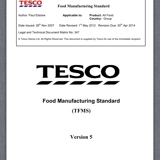Information
-
Document No.
-
Audit Title
-
Client / Site
-
Conducted on
-
Prepared by
-
Location
-
Personnel
18.1 - PACKAGING SUPPLIED TO LINE
-
Packaging supplied to the production line must be controlled and checked to ensure it is correct and for the right product
-
An 'issued to line' log is kept
18.2 - PACKAGING CHANGEOVER
-
At start up and changeovers, the line must be clear of any packaging not required for the next production run (including promotional packaging)
18.3 - CONTROL OF CODING
-
All coding information applied to the line must be correct and reflect the requirements as per the specification
-
Coding schedules and promotional information must be cross-checked by an authorised person prior to issue
-
The correct documented controlled coding schedule must be available on line with the date information
-
Coding information on the schedule is written in the same format as that on packaging
-
The authorised person has been trained and assessed as competent
-
Labels used for special promotions must be highlighted on the coding schedule with start and end date of labelling clearly stated
-
Changes in month and year must be highlighted on the coding schedule
-
Changes in bold or in a contrasting colour
-
Records with actual copies of the label must be authorised and retained
-
Aspirational - real time is printed on product labels
18.4 - CONTROL OF CODING
-
The time of any code changes must be agreed with Tesco and documented (eg what time does the code move to the next day - midnight or start of shift)
18.5 - CONTROL OF OFF LINE PRINTED PACKAGING
-
All off line printing must be controlled and checked
-
The material must be stored in a restricted access area until issued to the production line
-
An 'issued to line' log must be kept
18.6 - CONTROL OF CODED PACKAGING
-
All unused coded packaging must be accounted for and disposed of
18.7 - PRODUCT LABELLING
-
Product labelling and coding checks must be completed and documented at:
-
Start up
-
End of run
-
Hourly intervals
-
Or - in between / after line disruption, such as:
-
Reel changes
-
Fire-alarms
-
Breakdowns
-
Breaks
-
Coding checks must be completed for all runs and records including physical labels / sleeves retained
-
Checks include the cross checking of product label information against case/tray end labels
-
A sample of the actual code printed on the packaging from each check must be retained - including tray labels
-
Re-labelling of products due to printing faults or incorrect labelling must be done in a controlled manner
-
Records must be retained including details of reasons for re-labelling
18.8 - CONTROL OF BARCODES
-
Barcodes on all packaging must be checked against Tesco issued information before the packaging is used
-
There is a method in place for ensuring that the barcodes will scan
-
On line printed bar codes must be checked and recorded at regular intervals
-
Aspirational - a scanner is in place for the verification of barcodes
18.9 - CONTROL OF CODING
-
A labelling and coding procedure must be in place and include action to be taken in the event of an error
-
All personnel carrying out labelling and coding checks must be trained against the procedure
-
Where automated coding or label check systems are in place, checks must be carried out at a minimum start and end of product run:
-
Single coding and price master data file controlled by technical department
-
Password or key card protected system which identifies the person using the machine
-
Prevention system for reversal of display until and use by codes
-
Prevention system for incorrect coding at month end
-
Matching system for top and bottom labels, cans and labels or pots and lids etc
-
Checks must be in place in the event of a breakdown eg. Power failure
-
Aspirational - an automated coding or labelling checking system is in place














